art and architecture, Iranian
ancient art
Introduction
the art and architecture of ancient Iranian civilizations.
Any reservation about attributing to Iran primary status among the countries contributing to the art of the ancient Middle East must be associated with the discontinuity of its early history and the comparatively incomplete state of its archaeological exploration. Nevertheless, it is clear that Iranian art maintained a distinctive identity from prehistoric times onward; thus, characteristics seen in designs on painted pottery of the 4th millennium BC can also be recognized, for instance, in the sculpture of the Achaemenian Persians. One of these characteristics—manifest in bronze casting and stone carving as well as in painted ornament—is the predominance of decoration over representation. Such purely Iranian predilections seem, surprisingly, to have survived the historical hiatus in the 2nd and 3rd millennia BC, during which the more culturally advanced regions of the country were so profoundly influenced by the ideas and artistic formulas of neighbouring Mesopotamia. During the better-documented years of the 1st millennium, they again survived, side-by-side with the innovations imposed by Greek and other foreign craftsmen, and were later in fact reciprocally transmitted to Europe.
Early Iranian period
The most artistically important, though not the most ancient, prehistoric painted pottery of Iran is derived from Susiana (Elam) (Elam). The stylized shapes of animals and birds are used, their curves and contrasting angularities skillfully adapted to the sensitive shapes of the clay vessels in a manner that implies a long history of evolutionary experiment. The simplified silhouettes, which once must have appeared as individual figures, are linked together in a repetitive frieze to form a band of enrichment or to articulate some plastic feature. Nothing of this sort is to be seen in the contemporary Ubaid pottery of southern Mesopotamia, although the two cultures show a parallel progression.
In the succeeding Protoliterate period, each culture produced an independent form of pictographic (pictography) writing. In Iran, this development took place in Elam, a region bordering on southern and central Mesopotamia (art and architecture, Mesopotamian). The Elamite use of pictographs was short-lived, however, and for a long time no further attempt was made to develop a written language. Modern knowledge of Elamite history during the centuries that followed thus depends exclusively on references in Mesopotamian literature, occasioned by the perpetual contacts between the two countries. Trade was on a large scale, and even the wars that so frequently interrupted it supplied the Elamites with Mesopotamian goods, including works of art that could serve as a pattern for Iranian artists. The stelae of Naram-Sin and Hammurabi were among major works brought as loot to the Elamite capital at Susa, where they have since been found. It is thus understandable that the native products of Elamite artists in the 3rd millennium BC—statues, reliefs, and smaller objects, such as cylinder seals—followed the conventions current in Mesopotamia. One interesting exception is a type of carved steatite bowl, at first thought to be an Elamite product but since found at sites as far apart as Mari on the Euphrates and Mohenjo-daro in the Indus valley, where it originated, thus emphasizing the part played by Susa in transcontinental trade.

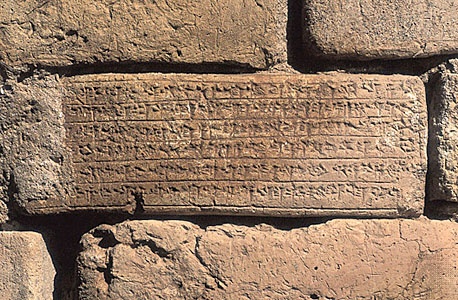
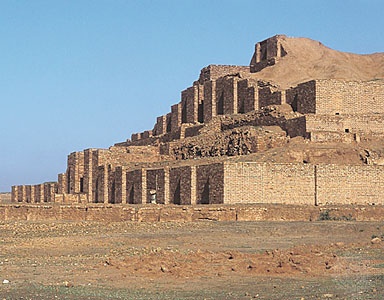 During the late 2nd millennium BC, Elam experienced a period of great prosperity and political stability under a line of powerful rulers. The character of Elamite architecture at this time was revealed by the discovery and excavation of a vast temple complex at Choghā Zanbīl (Dur Untash) in the Susa area. It was built by King Untash-Gal (c. 1265–c. 1245 BC) to fulfill the functions, first, of a holy shrine and centre of pilgrimage and, second, of a mausoleum for his family. Its central feature is a remarkably well-preserved ziggurat, 345 feet (105 metres) square and originally 144 feet (44 metres) high, built for the most part of baked bricks each weighing about 40 pounds (18 kg). Apart from the fact that it has been reconstructed with four receding stages and a summit temple, the structure of the ziggurat has little in common with that of Mesopotamian ziggurats. As described by one scholar,gates in the centre of each face led to diverging staircases up to the first stage, except on the southwest face, where a triple diverging staircase also led up to the second and higher stages.
During the late 2nd millennium BC, Elam experienced a period of great prosperity and political stability under a line of powerful rulers. The character of Elamite architecture at this time was revealed by the discovery and excavation of a vast temple complex at Choghā Zanbīl (Dur Untash) in the Susa area. It was built by King Untash-Gal (c. 1265–c. 1245 BC) to fulfill the functions, first, of a holy shrine and centre of pilgrimage and, second, of a mausoleum for his family. Its central feature is a remarkably well-preserved ziggurat, 345 feet (105 metres) square and originally 144 feet (44 metres) high, built for the most part of baked bricks each weighing about 40 pounds (18 kg). Apart from the fact that it has been reconstructed with four receding stages and a summit temple, the structure of the ziggurat has little in common with that of Mesopotamian ziggurats. As described by one scholar,gates in the centre of each face led to diverging staircases up to the first stage, except on the southwest face, where a triple diverging staircase also led up to the second and higher stages.Gates to the main stairways were flanked by glazed terra-cotta guardian animals—bulls or griffins. The paved area adjoining the ziggurat had a surrounding wall with imposing gateways. A similar outer wall enclosed a number of subsidiary temples, their dedication indicated by cuneiform inscriptions in the Elamite language. The ornamental sculptures (Western sculpture) from this complex were predominantly of glazed terra-cotta. A more striking example of contemporary Elamite sculpture is the life-size bronze statue of Queen Napirasu from Susa.
Median (Media) period
Much less is known about the northwestern part of modern Iran during the 2nd millennium BC, but from about 1000 BC onward it acquired a new importance. The southward migration of Indo-European peoples many centuries earlier, which had brought the Hittites to Anatolia and the Kassites to Babylon, was now followed by a new wave of peoples. Referred to as “Iranian,” these peoples included both the Persians and the Medes. At first they were little more than a loose confederation of tribes, occupying a wide area of Iran south of the Caspian Sea. In settling there they had bypassed the eastern provinces of Urartu and the prosperous country called Mannai, south of Lake Urmia, also avoiding contact with mountain tribes of Luristan. In the 8th and 7th centuries BC, however, the weakening of Urartu and Mannai by Assyrian conquests, followed by a Scythian invasion and the final collapse of Elam, made all of western Iran accessible, and the foundations of Median empire were laid by Cyaxares.
With this complicated infusion of new elements and influences, it is hardly surprising that the Iranian art of this period shows a rich synthesis of novel characteristics. Its most conspicuous surviving products are derived from four principal sources: an excavation at Hasanlu, which was probably the capital of the Mannaeans; a chance-found treasure from Ziwiye (Ziwiyeh) in Iranian Kurdistan; tomb finds at Marlik, near Kazvin; and excavated graves in Luristan (Laristan).
The Mannaean capital had a powerfully walled citadel, built between 1000 and 800 BC, and within it an enormous palace or temple, consisting of two-story buildings around a partially roofed courtyard. It had been destroyed by fire, and interest in its architecture, which should be considerable, has been eclipsed by the beauty of some objects recovered from the burnt debris. One was a silver cup decorated with electrum figures in two registers; there are chariots and soldiers above and, below, a lion and a horse opposed heraldically between archers. Even more remarkable was a bowl of solid gold (Archaeological Museum, Tehrān), elaborately figured with repoussé ornament, the religious or heroic imagery of which is largely incomprehensible. Though it shows no Assyrian influence, the associations of its linear style are with the West, and some links with Hurrian mythology have been detected in the design.
The hilltop fortress at Ziwiye falls within the territory of the Mannaean state, but the famous treasure found there dates from its later history (7th century BC). The marvelously designed objects making up the treasure include an elaborate pectoral ornament (jewelry), a bracelet with lions' heads, a similarly adorned torque (rigid necklace), a ram's head rhyton (drinking vessel), daggers, and enrichment for furniture—all of gold. As would be expected at this period, they show a variety of styles, sometimes combined in a single design, and carry suggestions of influence from Assyria, Syria, and even Egypt. The collection is thought by some to have been the property of a Scythian chief who temporarily ruled Mannai.
Dated to a period contemporary with the foundation of the Hasanlu citadel, though removed from it geographically, are the royal tombs found at Marlik. The tombs contained gold and silver vessels, comparable in design to those found at Hasanlu, and ingeniously grotesque animal figures in terra-cotta.
 The Luristan Bronzes include objects basically homogeneous in style but varying considerably in date and excavated from burial grounds in the eastern Zagros Mountains. There appear to have been more than 400 of these burial grounds, each comprising about 200 graves, so that the number of ornamental bronze (bronze work) objects reaching museums and private collections must have been very great. The burials appear to cover a long period of time; but two main groups have been distinguished, belonging, respectively, to the latter half of the 2nd millennium BC and to the Iron Age from 1000 BC onward. In the second period, particularly, there was a continual movement of Indo-European horsemen migrating from the north—a fact that helps to explain the character of the bronzes themselves, for they are nomads' gear. These portable goods and chattels of wandering tribes must have been produced by the settled craftsmen in the towns and villages of Iran for the nomads who passed through. Chariot or harness fittings are predominant: they include rein rings, bits, and ornaments, as well as weapons and various types of talismans. All suggest an indigenous school of craftsmanship catering to a changing clientele whose tastes and requirements varied with their origin. In the earlier group some very ancient Mesopotamian motifs are seen—rein rings, for instance, resembling those from the Ur tombs—but these have been explained as the belated use, in the 2nd millennium, of devices long superseded within Sumer itself.
The Luristan Bronzes include objects basically homogeneous in style but varying considerably in date and excavated from burial grounds in the eastern Zagros Mountains. There appear to have been more than 400 of these burial grounds, each comprising about 200 graves, so that the number of ornamental bronze (bronze work) objects reaching museums and private collections must have been very great. The burials appear to cover a long period of time; but two main groups have been distinguished, belonging, respectively, to the latter half of the 2nd millennium BC and to the Iron Age from 1000 BC onward. In the second period, particularly, there was a continual movement of Indo-European horsemen migrating from the north—a fact that helps to explain the character of the bronzes themselves, for they are nomads' gear. These portable goods and chattels of wandering tribes must have been produced by the settled craftsmen in the towns and villages of Iran for the nomads who passed through. Chariot or harness fittings are predominant: they include rein rings, bits, and ornaments, as well as weapons and various types of talismans. All suggest an indigenous school of craftsmanship catering to a changing clientele whose tastes and requirements varied with their origin. In the earlier group some very ancient Mesopotamian motifs are seen—rein rings, for instance, resembling those from the Ur tombs—but these have been explained as the belated use, in the 2nd millennium, of devices long superseded within Sumer itself.Achaemenian (Achaemenian Dynasty) period
There can be little doubt that, during the first half of the 8th century, when the Medes ruled northwestern Iran from their capital at Ecbatana (modern Hamadan), they developed some characteristic forms of architecture. This has been confirmed, for instance, by the discovery of a magnificent brick fortress at Nush-e Jan in that area. The evolution of a style capable of expressing the full genius of Iranian invention, however, fell to the lot of their Persian successors and fortunately is better documented by material remains.
The Persians first appear in history early in the mid-9th century BC as the occupants of a small state in Parsumash and Anshan, to the southeast of Susiana, ruled by a dynasty of kings to which its founder, Achaemenes, gave his name. Dependent first upon Elam and later subject to the Medes, the Persian state became more powerful in the 6th century, and in 550 BC, after defeating the Median armies, its fifth king, Cyrus II the Great, became ruler of all Iran. The empire that his further conquests created extended from Anatolia and Mesopotamia to the frontiers of India.
For Cyrus and his successors this access of temporal power and authority called for expression in the embellishment of their cities and the creation of an appropriately magnificent setting for their everyday lives. For an unsophisticated and hitherto nomadic people, this was an unprecedented requirement. Inspiration was at first sought in the existing formulas of Mesopotamia, Elam, Urartu, and Media, but from the beginning the matrix of the new style was the deep-seated artistic aptitude of the Iranians themselves. The marvels of Achaemenian art were conceived with native—and extraordinary—ingenuity. This continued to be the case even after the large-scale importation of Greek craftsmen in the time of Darius I (reigned 522–486 BC).
architecture
The earliest stages in the evolution of Achaemenian architecture are to be seen in the rather scanty remains of Cyrus's capital city at Pasargadae, north of Persepolis. The layout retained the character of a nomadic encampment: widely separated buildings—including gatehouse, residential palace, and audience hall—standing in a vast park surrounded by a wall 13 feet (4 metres) thick. The audience hall provides the earliest example of a formula in design that was to become a criterion of Achaemenian architecture: a columned hall with corner towers and external colonnades, called by the Persians an apadana (Apadāna). Other features are the Tomb of Cyrus, a gabled stone building on a stepped plinth, and a Zoroastrian fire temple (Zendan), a towerlike structure with a plan recalling that of the standard Urartian temple. Replicas of the Zendan were built later at Naqsh-e Rostam and elsewhere. Also at Pasargadae, the workmanship of Greek stonemasons was already recognizable, but their full contribution to the new Achaemenian style of architecture is better seen at Persepolis, to which Darius transferred the state capital in 518 BC.
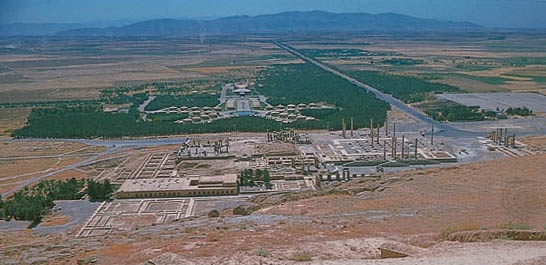 Achaemenian palaces (palace) are built on rock terraces leveled to receive them. The terrace at Persepolis measures approximately 1,600 × 1,000 feet (488 × 305 metres) and is more than 43 feet (13 metres) high, with traces of a high enclosure wall of mud brick around its outer edge and a magnificent stairway approach at its northeast corner. The palace buildings themselves, started by Darius in 518 BC and completed during the following half century by Xerxes I and Artaxerxes I, are rather closely grouped together, with little consideration for the overall composition. They are decorated, for the most part externally, with portal sculptures and long ranges of relief carving. Apart from the ornamental facades of the stairways by which the buildings are approached, sculpture is confined to the decoration of doors or windows. These stone-built features, together with a few internal columns, are all that have survived.
Achaemenian palaces (palace) are built on rock terraces leveled to receive them. The terrace at Persepolis measures approximately 1,600 × 1,000 feet (488 × 305 metres) and is more than 43 feet (13 metres) high, with traces of a high enclosure wall of mud brick around its outer edge and a magnificent stairway approach at its northeast corner. The palace buildings themselves, started by Darius in 518 BC and completed during the following half century by Xerxes I and Artaxerxes I, are rather closely grouped together, with little consideration for the overall composition. They are decorated, for the most part externally, with portal sculptures and long ranges of relief carving. Apart from the ornamental facades of the stairways by which the buildings are approached, sculpture is confined to the decoration of doors or windows. These stone-built features, together with a few internal columns, are all that have survived. In the absence of the mud-brick walls themselves, it is difficult to gain a true impression of the terrace's original appearance. Most characteristic of these Persian palaces is the proliferation of columns (column) and the tendency to plan them around a square central chamber. In the main gatehouse, with its guardian bulls and bull-men, the square appears as an independent unit. Facing it at a higher level is the largest building of all, the great Apadana (hall) of Darius. It is 272 feet (83 metres) square and is said to have accommodated 10,000 people. The four corner towers presumably contained guardrooms and stairs. The sculptured stairway by which it was reached bears the famous relief of the tribute bearers. Next comes the Throne Hall, or Hall of a Hundred Columns. It has a portico on the north side with 16 pillars and guardian bulls built into the tower walls at either end. Seven sculptured windows in the north wall are balanced by corresponding niches elsewhere, and the reveals, or jambs, of the doors also are decorated with reliefs. Again approached by an ornamental stairway, a “tripylon” unit between these main buildings leads to others only tentatively identified. The plan of the building, called the Harlem by archaeologists, is to some extent self-explanatory. The character of the Treasury is indicated by security precautions in its planning. In this building the columns were of wood, heavily plastered and painted in bright colours. Elsewhere, columns are fluted in the Greek manner, while the more elaborate capitals and bases have a floral treatment that, like much other Achaemenian ornament, is half Greek and half Egyptian. The most notable form of capital and one peculiar to Achaemenian design is the “double-figure” impost (an upper addition to the capital), taking the form of paired bulls, bull-men, or dragons. Some of these features reappear in the contemporary palace at Susa. Also from this source are figured panels of molded and glazed brick, reminiscent of Nebuchadrezzar's Babylon.
In the absence of the mud-brick walls themselves, it is difficult to gain a true impression of the terrace's original appearance. Most characteristic of these Persian palaces is the proliferation of columns (column) and the tendency to plan them around a square central chamber. In the main gatehouse, with its guardian bulls and bull-men, the square appears as an independent unit. Facing it at a higher level is the largest building of all, the great Apadana (hall) of Darius. It is 272 feet (83 metres) square and is said to have accommodated 10,000 people. The four corner towers presumably contained guardrooms and stairs. The sculptured stairway by which it was reached bears the famous relief of the tribute bearers. Next comes the Throne Hall, or Hall of a Hundred Columns. It has a portico on the north side with 16 pillars and guardian bulls built into the tower walls at either end. Seven sculptured windows in the north wall are balanced by corresponding niches elsewhere, and the reveals, or jambs, of the doors also are decorated with reliefs. Again approached by an ornamental stairway, a “tripylon” unit between these main buildings leads to others only tentatively identified. The plan of the building, called the Harlem by archaeologists, is to some extent self-explanatory. The character of the Treasury is indicated by security precautions in its planning. In this building the columns were of wood, heavily plastered and painted in bright colours. Elsewhere, columns are fluted in the Greek manner, while the more elaborate capitals and bases have a floral treatment that, like much other Achaemenian ornament, is half Greek and half Egyptian. The most notable form of capital and one peculiar to Achaemenian design is the “double-figure” impost (an upper addition to the capital), taking the form of paired bulls, bull-men, or dragons. Some of these features reappear in the contemporary palace at Susa. Also from this source are figured panels of molded and glazed brick, reminiscent of Nebuchadrezzar's Babylon.Sculpture (Western sculpture)
Relief sculpture (relief) is by far the most striking manifestation of Achaemenian art. Adopted as the basis of the new style was the straightforward technique of the Assyrians, with its engraved detail and lack of modeling. The employment of Ionian sculptors resulted in a complete break with this tradition, and the full plastic rendering of human or animal figures became the rule. A compromise between the aesthetic sensibility of the Greek sculptors and the disciplined precision of the Iranian tradition in metalwork produced a stylistic synthesis of unrivaled elegance.
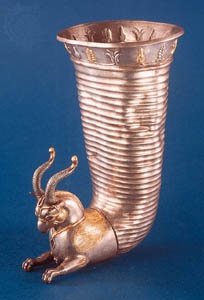 Compared with the spirit and variety of the Assyrian narrative scenes, the subjects chosen for the Persian designs may at times appear monotonous. This may be partly explained, however, by the disparity in their architectural functions: the reliefs no longer appeared as interior decoration but were effectively used to give visual emphasis to prominent features of external facades where the bright colours applied to them profited from the sunshine. Well-known Achaemenian rock reliefs, such as those of the royal tombs at Naqsh-e Rostam, near Persepolis, and the relief with a famous inscription of Darius I at Bīsitūn (historically Behistun), on the road to Hamadan, are primarily of archaeological interest. Of greater artistic importance are the many surviving examples of Achaemenian metalsmiths (metalwork)' work, which continued to draw extensively on the native tradition of Iranian design. The Oxus Treasure includes outstanding and characteristic examples of Achaemenian metalwork.
Compared with the spirit and variety of the Assyrian narrative scenes, the subjects chosen for the Persian designs may at times appear monotonous. This may be partly explained, however, by the disparity in their architectural functions: the reliefs no longer appeared as interior decoration but were effectively used to give visual emphasis to prominent features of external facades where the bright colours applied to them profited from the sunshine. Well-known Achaemenian rock reliefs, such as those of the royal tombs at Naqsh-e Rostam, near Persepolis, and the relief with a famous inscription of Darius I at Bīsitūn (historically Behistun), on the road to Hamadan, are primarily of archaeological interest. Of greater artistic importance are the many surviving examples of Achaemenian metalsmiths (metalwork)' work, which continued to draw extensively on the native tradition of Iranian design. The Oxus Treasure includes outstanding and characteristic examples of Achaemenian metalwork.Seleucid (Seleucid kingdom) period
The two centuries during which the Middle East and countries beyond were ruled by Alexander the Great (336–323 BC) and his Seleucid successors (312 BC–64 BC) are poorly represented in the realm of art and architecture. Everywhere in the Middle East, local artists were subject to strong Western influence, and Western craftsmen adapted their taste to that of a Greek or Hellenistic aristocracy. If there was a Greco-Iranian style, it had little to distinguish it from Greco-Mesopotamian or, for that matter, Greco-Indian art. architecture of about 200 BC is represented by two “Greek” temples (temple), at Kangāvar and Khurha, in Iran, in which classical orders (Doric, Ionic, and Corinthian) are handled with so little understanding that they can hardly be called Hellenistic. There are, however, isolated examples of contemporary sculpture (Western sculpture) from eastern sites to which this term could be more justifiably applied. Bronze statuettes from Nahāvand, a fine bronze head from Shami in the Bakhtiari, the marble fragments from Susa, and a striking alabaster statue from Babylon acquire added interest from their provenances.
Parthian (Parthia) period
The Parthians were a nomadic people originating in the steppe country between the Caspian and Aral seas. The dynasty of Parthian kings that was to displace the Seleucid rulers of western Asia was founded in about 250 BC. One hundred years later, their conquests extended as far as Mesopotamia, and the frontier of Europe was withdrawn to the Euphrates. For another four centuries the further extension of the Parthian empire was resisted with varying degrees of success by the armies of Rome.
In Iran and Mesopotamia, this long era of Parthian occupation is poorly represented by newly built (architecture) towns, but there are a few notable examples. One was Ctesiphon, originally a Parthian military camp facing Seleucia, the older capital city on the other side of the Tigris River. Another was Hatra, a fortress city in the Al-Jazīrah desert between the Tigris and Euphrates rivers; and a third was Gūr-Fīrūzābād, south of Shīrāz. All these show the approximately circular plan of military tradition. The palaces (palace), sometimes built of good ashlar masonry, and even the private houses are distinguished by a feature later characteristic of Islamic architecture: the iwan, or three-sided hall, the fourth side of which is replaced by an open archway. At Hatra and in a Parthian palace at Ashur, the iwans multiplied in number, and the adjoining facades are decorated with engaged columns, singly or in tiers, corresponding approximately to the orders of classical architecture.
Hatra is by far the best preserved and the most informative example of a Parthian city. It has an inner and an outer city wall, the former built of ashlar masonry, and a temenos (temple enclosure) enclosing the principal sacred buildings. The great central group, built during the 2nd and 1st centuries BC and still standing with many of its vaulted chambers intact, includes the Shamash temple, a characteristic Iranian sanctuary with a square central chamber, ambulatory, and outer wall incorporating a staircase to the roof. Comparable buildings have been found as far afield as Taxila in the Indus valley. Excavations by Iraqi archaeologists have revealed temples dedicated to Al-Lāt and Shahiro, who, with Shamash, make up a Hatran trinity.
In the 1st and 2nd centuries AD Hatra was ruled by a dynasty of Arab princes whose written language was Aramaic. Iraqi excavations have yielded a great wealth of sculptures (Western sculpture) dating from this period, including portrait statues of the princes and their families. This material has thrown new light on the whole subject of Parthian art, which depended formerly on such isolated survivals as the magnificent bronze statue from Shami, in the old Elamite homeland. Rock reliefs at Tang-e Sarwak, Bīsitūn, and elsewhere reveal one salient characteristic of Parthian design—that is, the preference for “frontality” or, as one scholar describes it, “the tendency for the figures to ignore one another and to face the spectator with an unblinking stare.” Frontality also is characteristic of the Romano-Syrian sculptures of Palmyra and later passed into the fabric of Byzantine art.
Petra and Palmyra
Two cities, strategically placed in Jordan and eastern Syria, respectively, were at times associated with Parthian history and have left monuments suggesting a compromise between Roman and Middle Eastern art. Both were caravan cities, and each in turn acquired wealth and importance from its position at the junction of arterial trade routes. Petra, in biblical Edom, was ruled by Nabataean kings from late in the 2nd century BC until AD 106, when it became a Roman colony. Its subsequent decline was due in part to the temporary ascendancy of Palmyra, on the western fringe of the Syrian desert, whose remarkable queen Zenobia ruled a miniature empire until she was defeated by the Romans in AD 272.
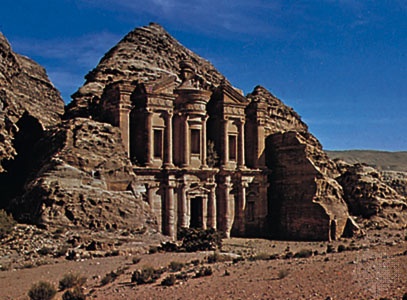 The significance of Petra in the history of ancient Middle Eastern art is difficult to assess, since its art is in large part restricted to the design of rock-cut tombs (tomb) or temples (temple). Imitation building facades carved on cliff faces surround the tomb and temple entrances. Their most distinctively Oriental characteristic is the baroque effect obtained by ingenious contortions of classical Roman formulas. The dramatic beauty of their natural setting and the chromatic peculiarity of the stone from which they were hewn are assets that have enhanced their reputation. Stripped of these, their interest is primarily academic.
The significance of Petra in the history of ancient Middle Eastern art is difficult to assess, since its art is in large part restricted to the design of rock-cut tombs (tomb) or temples (temple). Imitation building facades carved on cliff faces surround the tomb and temple entrances. Their most distinctively Oriental characteristic is the baroque effect obtained by ingenious contortions of classical Roman formulas. The dramatic beauty of their natural setting and the chromatic peculiarity of the stone from which they were hewn are assets that have enhanced their reputation. Stripped of these, their interest is primarily academic. The architecture of Palmyra is more conventionally Roman, but it is freely associated with sculpture, and many bas-relief carvings decorate the tombs of rich merchants and other notables. Parthian influence is to be seen in their style, particularly in the frontality of the human figures.
The architecture of Palmyra is more conventionally Roman, but it is freely associated with sculpture, and many bas-relief carvings decorate the tombs of rich merchants and other notables. Parthian influence is to be seen in their style, particularly in the frontality of the human figures.Sāsānian (Sāsānian dynasty) period
The last great Iranian dynasty to rule in the Middle East before the advent of Islam has left a heritage of ruined buildings and sculpture that are of increasing interest to those seeking the origins and antecedents of Western art. It has been said of Sāsānian art that, essentially Iranian in character, “it was receptive of foreign influences, but adapted them to the traditions of its native land, and as the art of a world empire, it spread into far distant countries.”
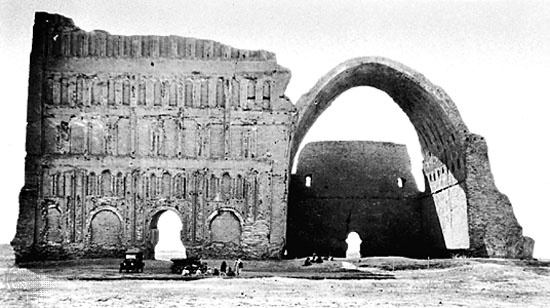 A town called Gūr (modern Fīrūzābād) was built by the founder of the dynasty, Ardashīr I (reigned AD 224–241), with the circular plan characteristic of earlier times. A contrast is immediately seen at Bishāpūr, where Ardashīr's son Shāpūr I adopted the “grid” planning then popular in Greek cities. Building materials varied from country to country. The Sāsānian palace at Ctesiphon was built (probably in the 4th century AD) of baked brick. The facades on either side of its famous vaulted iwan hall (82 feet 【25 metres】 wide and 121 feet 【37 metres】 high) have blind arcading with freely simplified classical detail. A reconstruction of the palace at Gūr, built of rubble and plaster, shows a similar main facade, with cupolas (rounded vaults) over square chambers behind. Of the same material is Shāpūr I's palace at Bishāpūr, where the great hall, with its central cupola, has four iwans making a cruciform (in the form of a cross) plan. In buildings of this sort, the stucco facing of the walls was decorated with incised or painted ornament. There were also mosaic pavements, in which portraits of individuals were shown three-quarters face, the frontality of Parthian design apparently having been abandoned.
A town called Gūr (modern Fīrūzābād) was built by the founder of the dynasty, Ardashīr I (reigned AD 224–241), with the circular plan characteristic of earlier times. A contrast is immediately seen at Bishāpūr, where Ardashīr's son Shāpūr I adopted the “grid” planning then popular in Greek cities. Building materials varied from country to country. The Sāsānian palace at Ctesiphon was built (probably in the 4th century AD) of baked brick. The facades on either side of its famous vaulted iwan hall (82 feet 【25 metres】 wide and 121 feet 【37 metres】 high) have blind arcading with freely simplified classical detail. A reconstruction of the palace at Gūr, built of rubble and plaster, shows a similar main facade, with cupolas (rounded vaults) over square chambers behind. Of the same material is Shāpūr I's palace at Bishāpūr, where the great hall, with its central cupola, has four iwans making a cruciform (in the form of a cross) plan. In buildings of this sort, the stucco facing of the walls was decorated with incised or painted ornament. There were also mosaic pavements, in which portraits of individuals were shown three-quarters face, the frontality of Parthian design apparently having been abandoned.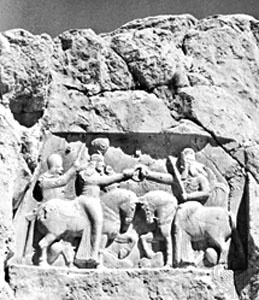 The most important and revealing examples of Sāsānian sculpture (Western sculpture) are the rock reliefs scattered over the territory of the empire; there are more than 30 in Iran alone. Their style and content reveal a facet of art history that can do much to clarify the interaction of Eastern and Western ideas at this time. The scenes generally depicted are investitures, triumphs, the defeat of enemies, and other occasions in the life of royalty. Perhaps the two most striking designs in the whole series, each of them characteristic yet differently conceived, are the Investiture of Ardashīr I at Naqsh-e Rostam and the Royal Hunt relief at Tāq-e Bostān (Ṭāq-e Bostān). In the first the king and his god, both mounted on horseback, are sculptured in high relief in the Roman manner but are antithetically arranged to create a typically Iranian heraldic composition. In the second the two central figures are framed in a surrounding panorama of incidental detail, perhaps inspired by similar designs in mural painting. These and other examples reveal Western influence—for instance, in the molding of drapery of the body or the Achaemenian arrangement of subordinate figures in horizontal registers. Yet, unlike Achaemenian sculpture, there is no narrative intention in these reliefs. Their static celebration of a single event, investing it with a timeless significance, is the central accomplishment of this form of Sāsānian art.
The most important and revealing examples of Sāsānian sculpture (Western sculpture) are the rock reliefs scattered over the territory of the empire; there are more than 30 in Iran alone. Their style and content reveal a facet of art history that can do much to clarify the interaction of Eastern and Western ideas at this time. The scenes generally depicted are investitures, triumphs, the defeat of enemies, and other occasions in the life of royalty. Perhaps the two most striking designs in the whole series, each of them characteristic yet differently conceived, are the Investiture of Ardashīr I at Naqsh-e Rostam and the Royal Hunt relief at Tāq-e Bostān (Ṭāq-e Bostān). In the first the king and his god, both mounted on horseback, are sculptured in high relief in the Roman manner but are antithetically arranged to create a typically Iranian heraldic composition. In the second the two central figures are framed in a surrounding panorama of incidental detail, perhaps inspired by similar designs in mural painting. These and other examples reveal Western influence—for instance, in the molding of drapery of the body or the Achaemenian arrangement of subordinate figures in horizontal registers. Yet, unlike Achaemenian sculpture, there is no narrative intention in these reliefs. Their static celebration of a single event, investing it with a timeless significance, is the central accomplishment of this form of Sāsānian art.Additional Reading
General works on ancient Middle Eastern arts include Henri Frankfort, The Art and Architecture of the Ancient Orient (1954, reissued 1995), a full critical study by an eminent scholar, now somewhat outdated; H.A. Groenewegen-Frankfort, Arrest and Movement: An Essay on Space and Time in the Representational Art of the Ancient Near East (1951, reprinted 1987), a detailed study of aesthetic values and symbolic abstractions; Seton Lloyd, The Art of the Ancient Near East (1961), a well-illustrated survey for the general reader; and R.W. Ferrier (ed.), The Arts of Persia (1989), with an extensive bibliography. Edith Porada and R.H. Dyson, The Art of Ancient Iran: Pre-Islamic Cultures (also published as Ancient Iran: The Art of Pre-Islamic Times, 1965; originally published in German, 1962), is also useful.Iranian art is treated in Roman Ghirshman, Persia: From the Origins to Alexander the Great (also published as The Arts of Ancient Iran from Its Origins to the Time of Alexander the Great, 1964; originally published in French, 1963); and Malcolm A.R. Colledge, Parthian Art (1977). Ed.
- Alushta
- Aluízio Azevedo
- Alva
- Alva Belmont
- Alvar Aalto
- Alvarado, Pedro de
- Alva Reimer Myrdal
- Alvarez, A.
- Alvarez, Luis W.
- Alvaro, Corrado
- Alvear, Marcelo T de
- Alvensleben-Erxleben, Gustav, Graf von
- Alvin Ailey, Jr.
- Alvin Cullum York
- Alvin Harvey Hansen
- Alvin, Jr. Ailey
- Alvin Kraenzlein
- Alvin Langdon Coburn
- Alvin Poussaint
- Alvise Ca' da Mosto
- Alvise Vivarini
- al- Walīd
- al- Walīd ibn Yazīd
- Alwar
- Al White